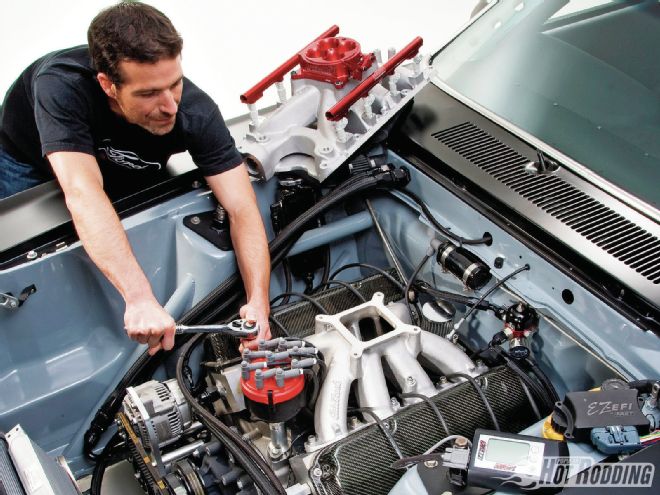
EFI conversions have been available from the aftermarket almost from the time EFI systems became universal as OEM equipment. Over those years, the systems and their software have undergone continual refinement, with better components and more capable electronics, as well as improved software. The goals in this development process are qualities that anyone can appreciate—reliability, tunability, and flexibility over a broad range of applications. The sophistication of today’s stand-alone engine management systems has reached a very high level.
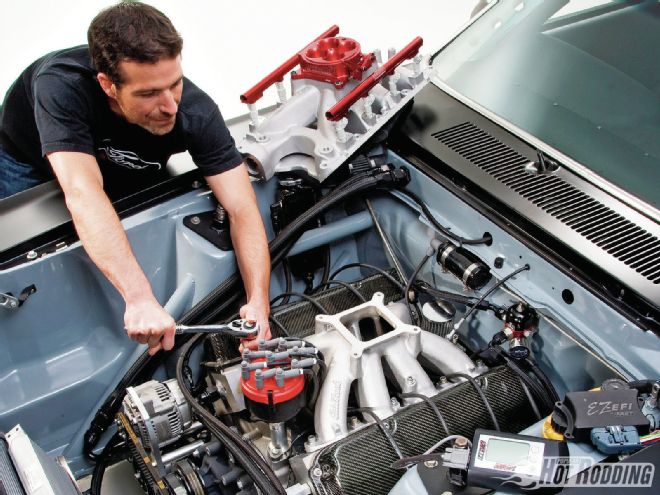
At the end user level, however, it is helpful to consider the motivations and the expectations of the enthusiast considering a conversion to EFI. For starters, one might ask just why a guy might consider trading in that reliable old carburetor for an admittedly pricey EFI system. In the realm of normally aspirated high-performance engines, the usual objectives are to achieve the same kinds of advancements in efficiency and driveability associated with a modern car. Turn the key, and it fires right up. Run up to a light and it will idle without loading the plugs or requiring the old two-foot peddling to keep it running. Basically, the ideal fuel injection system promises the dream of putting away the jet kit and screwdrivers, with the expectation that it will perform under a variety of conditions with minimal attention. The capability of achieving these goals has been built into the systems for several years now, but achieving that level of execution is often another story.
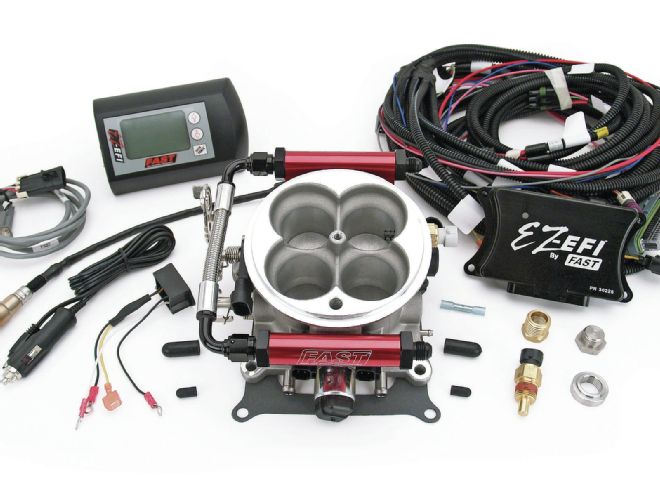 The most basic of the FAST EZ-EFI systems incorporate a four-injector throttle body, which is a direct replacement for a 4150 carburetor. This arrangement provides the simplest and most basic conversion to EFI.
The most basic of the FAST EZ-EFI systems incorporate a four-injector throttle body, which is a direct replacement for a 4150 carburetor. This arrangement provides the simplest and most basic conversion to EFI.
EFI has spawned a whole new breed of hot rodder as an answer, a guy who just didn’t exist back in the day: the “tuner.” Armed with a laptop and a dyno, this cat works the fuel and spark tables, and the various other tuning offsets to really dial in an EFI system. The problem from an enthusiast’s point of view is that tuners and dynos cost money, and most end users are not “tuners.” Needless to say, hiring a specialist to “tune” an EFI system adds considerably to the time and money needed to optimize an EFI system, and even then the results will vary with the competence of the guy working the keyboard.
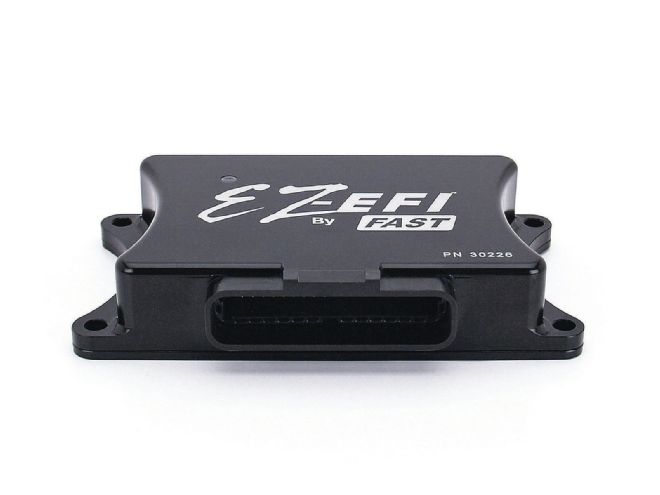 The real key to the new generation of self-tuning is hidden in this black box, the ECU which controls the system. The secret is in the coding and strategies developed by the manufacturer. The goal is to take laborious tuning process and make it automatic, once a few basic inputs are provided.
The real key to the new generation of self-tuning is hidden in this black box, the ECU which controls the system. The secret is in the coding and strategies developed by the manufacturer. The goal is to take laborious tuning process and make it automatic, once a few basic inputs are provided.
From a practical standpoint, for the vast majority of enthusiasts considering an EFI conversion, the ideal situation would be the ability to just bolt on the hardware, wire-up the electronics, and then hit the streets. This is where the latest technological trend in aftermarket EFI system seems to be centered. Enter the self-compensating or self-learning EFI system. The goal here is to largely take the rigorous tuning process out of the aftermarket EFI conversion by having the system tune itself. Here we take a look at three popular new-generation EFI systems, and the logic behind each.
FAST EZ-EFI
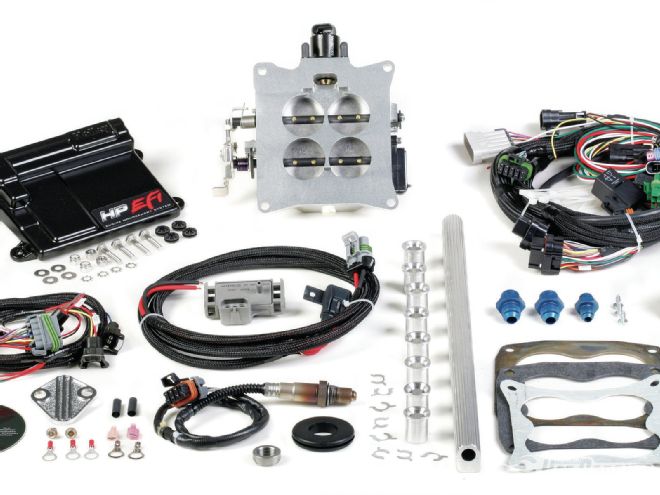 Holley has entered the fray with their next generation of self-learning EFI systems. Again, the secret to making it work is the logic programmed into the ECU. Holley has stepped in with three systems with varying levels of engine control capabilities, with their Avenger, HP, and Dominator systems.
Holley has entered the fray with their next generation of self-learning EFI systems. Again, the secret to making it work is the logic programmed into the ECU. Holley has stepped in with three systems with varying levels of engine control capabilities, with their Avenger, HP, and Dominator systems.
Fuel Air Spark Technology (FAST) has long been a leader in EFI conversion components, and when the conversation shifted to end user–friendly systems, FAST’s answer was the EZ-EFI system. As the name implies, the objective with the EZ system is to make the conversion to EFI as easy as possible. To that end the real change is in the ability of the electronics to self-tune. The premise is to allow the installer to simply bolt on the components, and follow through with a basic setup procedure on the included handheld display, and the system will take the fine-tuning from there. The electronics look at the targeted air/fuel ratio and adjusts to those requirements through what is a very involved set of parameters in the unit’s programming itself.
The most popular EZ-EFI conversion is a throttle-body injection system, which uses a 1,000-cfm throttle body that is a direct replacement for a 4150 carb. With this conversion the carburetor on an existing intake manifold is simply replaced with the throttle-body injection unit from FAST, along with the electronics and fuel system to make it work. The throttle body includes four 85-lb/hr injectors, making the system good for engines up to 600 hp, and these TBI units can be ganged in tandem for a dual-quad installation of upward of 1,000 hp. The real upshot of this arrangement is that as far as the engine is concerned, you are just replacing the carb with the throttle body and its associated components. The EZ-EFI system is a fuel-only EFI, so all of the ignition functions are still handled by the existing distributor or ignition system.
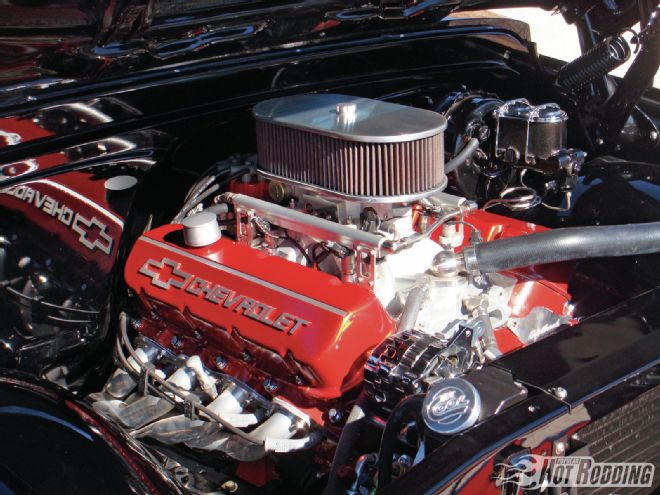 The beauty of the Mass-Flo system is that it will self-compensate for a variety of engine component changes, since the measured airflow will change correspondingly. This installation on a Chevy big-block will work just as well after a cam change, a new header collector, head upgrade, or other engine modifications.
The beauty of the Mass-Flo system is that it will self-compensate for a variety of engine component changes, since the measured airflow will change correspondingly. This installation on a Chevy big-block will work just as well after a cam change, a new header collector, head upgrade, or other engine modifications.
Although the EZ-EFI in its most basic form is a simple replacement for a carburetor, the same smart electronic controls are also capable of supporting port fuel injection. This covers modern engine applications such as GM’s LS, Ford’s new Coyote, or Chrysler’s Hemi. The FAST EZ-EFI facilitates simplified retrofits of these engines into earlier cars or street rods without the necessity of dealing with the complex OEM engine management system and wiring. For applications where port injection is preferred as a retrofit, the EZ-EFI is adaptable to existing port EFI installations as an adaptive fuel control electronics package, or as a complete retrofit for popular applications, including the manifold, fuel rails, injectors, and air-only throttle body.
The problem from an enthusiast’s point of view is that tuners and dynos cost money, and most end users are not ‘tuners.’
While the self-tuning capability is the calling card of the EZ-EFI system, there is still the capacity to provide user inputs to influence the tune. From the target air/fuel ratio to such nuances as “accelerator pump shot duration,” the system allows inputs to influence the tune. If you want to know how your machine would perform on the dragstrip with a little bit richer mixture, the tuning capabilities are there with a simple entry via the handheld display. FAST also offers the same self-tuning technology in their higher-end engine management systems.
Holley
While many enthusiasts instantly identify Holley with their famous line of carburetors, Holley was early to embrace the concept of the aftermarket retrofit EFI system. These systems have been regularly updated from the primitive dials and dip switches of the earliest controls, to the state-of-the-art electronics of today. As might be expected, Holley has jumped to the forefront of the trend to self-tuning engine management, with a full-spectrum line of new ECUs with these capabilities. These new control boxes come in three series: Avenger, HP, and Dominator.
Unlike the carbs by the same names, these various EFI systems are all suitable for a full range of applications, with the difference being the capabilities of the ECU itself. All have the self-learning capacity, which allows these units to dial-in their own tune. The Avenger is the most basic of the three ECUs. It has the fewest features but includes everything you need for a typical carburetor-to-EFI conversion. This system is ideally suited as a retrofit to a throttle-body type injection system, or to run a multiport injection system in a batch-fired strategy. The Avenger uses a simple handheld tuning module for easy set-up, and allows for user inputs for setting the tuning parameters. The Avenger can be run as a fuel-only control, but also has ignition control capabilities allowing computer controlled ignition timing if desired.
…the ideal situation would be the ability to just bolt on the hardware, wire-up the electronics, and then hit the streets
The next step up is the HP-Series system, with the HP ECU at the heart. Naturally, this engine management system employs Holley’s latest self-learning strategies, but where it differs from the Avenger is in its capabilities. With eight injector drivers, the controller will operate a V-8 engine in full sequential mode, which means this system is ideal for most port injection setups. On the ignition side, the HP has an eight-channel distributor output to operate coil-on-plug ignition systems, and is plug-and-play ready for GM LS engines with 24x or 58x crank trigger wheels. This only scratches the surface of the HP’s capacity, with other features such as four programmable input and output channels to support devices like boost control, progressive nitrous, water/meth injection, speed inputs, fuel pump control, AC inputs, timing retard inputs, and various other uses.
At the top of the spectrum is the Dominator Series system. Again, the step up is in system capabilities, and the Dominator ECU has it all and more. Inside there are 12 injector drivers, 12 channels of distributor-less ignition output, and the input and output auxiliary channels to run just about any engine system imaginable. The system even has integrated transmission controls for GM 4L60/80E transmissions, and astounding data-logging capabilities. The full list of features is far more than we can outline here, but we can say if you are looking for the maximum level of control capabilities in a system with self-tuning logic, the Dominator delivers the goods.
Mass-Flo
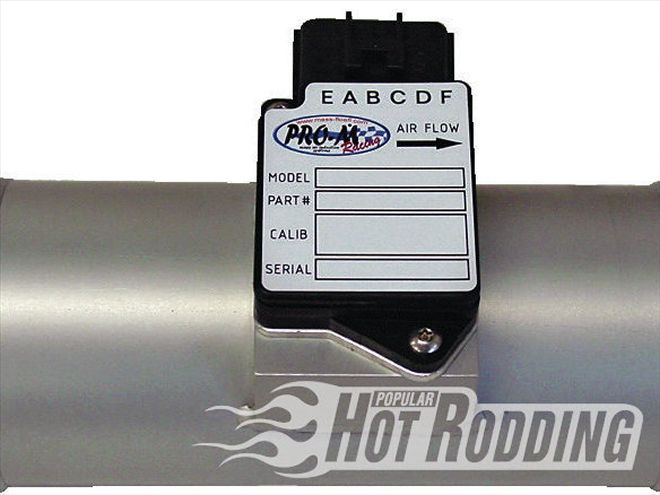 Mass-Flo takes an approach that differs from the more common speed/density operating strategies of competing EFI systems. The key component here is a mass airflow sensor that provides real-time information on the quantity of air the engine is using, allowing the fuel to be matched at a corresponding level.
Mass-Flo takes an approach that differs from the more common speed/density operating strategies of competing EFI systems. The key component here is a mass airflow sensor that provides real-time information on the quantity of air the engine is using, allowing the fuel to be matched at a corresponding level.
Taking a different strategy to the goal of self-compensating EFI systems are the offerings from Mass-Flo. While the other systems rely on variations of the speed-density strategy, as the name implies, Mass-Flo uses a mass-flow strategy, centering upon the readings of a mass airflow sensor. This is the strategy used by most OEM EFI systems, using the actual measured quantity of air as signaled by the mass airflow sensor to form the basis for the required amount of fuel. In fact, Mass-Flo uses OEM ECUs, which are built to a very high degree of reliability, and have the sophistication of OEM-level engineering built in.
The beauty of using a mass flow is that the amount of air entering the engine is constantly monitored, and the air/fuel ratio is proportionally adjusted to compensate for the load and operational conditions as recorded by the engine sensors. This makes the system very neutral to changes in the engine combination, allowing substantial changes to the basic engine configuration without the arduous re-tuning process required of a typical speed/density system. With changes in specifications, such as a cam swap, new heads, or intake and exhaust changes, the Mass-Flo system will measure the resultant change in airflow directly, and always compensates with a proportional change in fuel quantity. If very large changes are made requiring a change in injector size, the ECU can be sent in to Mass-Flo and recalibrated.
Mass-Flo provides a complete engine management system, with full ignition and sequential fuel control in every system. As far as the tuning, the mass air system takes care of the details in a way that a carburetor or speed density system just isn’t capable of. This makes the Mass-Flo system remarkably user-friendly. The goals are improved power, torque, fuel economy, performance, and reliability. In contrast to a conventional programmable speed density system, the end user will never have to tune this system. The cost savings are obvious here, with no need to employ the services of a professional tuner, and no need for the dyno service usually associated with tuning an EFI system. This also saves time and the logistics of getting a vehicle to the dyno. With the Mass-Flo system, once it is installed, you are done.